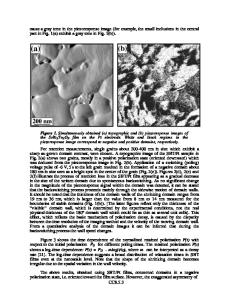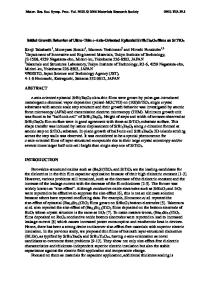(200)-predominant growth of radio-frequency sputtered SrBi 2 Ta 2 O 9 thin films
- PDF / 648,528 Bytes
- 8 Pages / 612 x 792 pts (letter) Page_size
- 59 Downloads / 316 Views
Ki Hyun Yoon Department of Ceramic Engineering, Yonsei University, Seoul 120-749, Korea (Received 19 Decemer 2001; accepted 20 March 2002)
SrBi2Ta2O9 (SBT) thin films were prepared by the radio-frequency (rf) magnetron sputtering method on Pt/Ti/SiO2/Si substrates. The composition and orientation of SBT thin films were changed by the control of sputtering parameters such as pressure and rf power. As the sputtering pressure increased from 2.5 to 300 mtorr, the film was changed from Sr- and Bi-deficient SBT film to stoichiometric film. The SBT thin films with stoichiometric composition showed good electrical properties. As the rf power increased from 25 to 40 W, the Sr content decreased. However, the Bi content was maximized in the power of 30 W, where the (200)-predominant SBT thin films were fabricated. In lower power of 25 W, typical polycrystalline SBT films were obtained. The Sr and Bi contents in both films were not deficient. However, at the higher power of 35 and 40 W, the secondary phase appeared due to the Sr deficiency. The Bi content of (200)-predominant SBT film was higher than that of polycrystalline films. The degree of the (200) orientation depended on the magnitude of excess Bi content. It is also suggested that the (200)-predominant SBT films were formed by the decomposition of SBT phase to the Bi and Sr atoms caused by rf power control and the lower atomic migration energy along the a axis.
I. INTRODUCTION
Among ferroelectric materials, SrBi2Ta2O9 (SBT) thin film is one of the strong candidates for nonvolatile memory applications due to its fatigue resistance with Pt electrodes.1 It belongs to the Aurivillius family with two SrTaO3 perovskitelike units between (Bi2O2)2+ layers along the c axis.2 As a result, the ferroelectric properties are expected to be very anisotropic, and it is observed that the ferroelectricity along the c axis is absent or very low.3,4 Therefore, it is desirable to control the crystal orientation of SBT thin films for practical application. However, the SBT thin films deposited on Pt electrodes, which usually used in ferroelectric films deposition, generally show c-axis preferential orientation or polycrystalline structure.5–7 Moreover, the a-axis SBT films have been hardly grown on the usual Pt (111) substrate due to the different atomic configurations between perovskitelike units and Bi-layer along the crystallographic axis.7
a)
Also at Department of Ceramic Engineering, Yonsei University, Korea. b) Address all correspondence to this author. e-mail: [email protected] J. Mater. Res., Vol. 17, No. 6, Jun 2002
http://journals.cambridge.org
Downloaded: 17 Mar 2015
There are several reports on the non-a-axis epitaxial growth of SBT or SrBi2Nb2O9 (SBN) thin films by pulsed laser deposition (PLD),4,8 metalorganic chemical vapor deposition9 and radio-frequency (rf) sputtering.10 It was reported that (001)-, (116)-, and (1.03)-oriented SBT films can be grown on oxide single crystal substrates of certain crystallographic orientations such as SrTiO3 (100), (110), and (111),
Data Loading...











